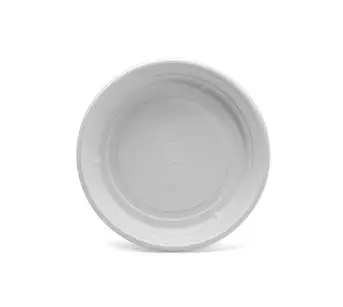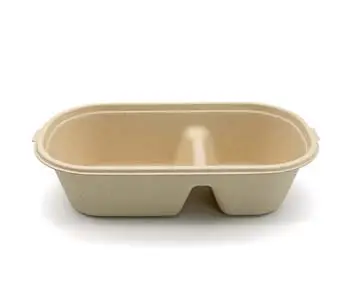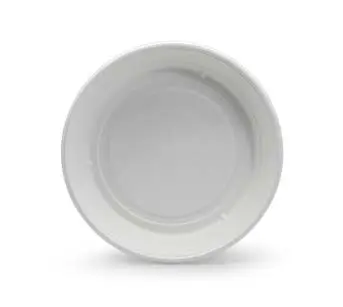Definition of Compostable Plates
Compostable plates are a remarkable and revolutionary alternative to traditional disposable plates that are designed to break down naturally and return to the earth, leaving no harmful residues behind. Made from organic and renewable materials such as fallen leaves, sugarcane bagasse, or bamboo, these plates are specifically engineered to be biodegradable and compostable.
For eco-conscious events and gatherings, compostable catering trays present an elegant and earth-friendly option. Crafted from organic and renewable materials, such as sugarcane bagasse or bamboo, these trays not only provide a sustainable solution for serving food but also demonstrate a commitment to reducing waste and environmental impact, adding an extra touch of elegance to weddings and other special occasions.
Unlike conventional plastic or Styrofoam plates that take hundreds of years to decompose in landfills, compostable plates can transform into compost within a matter of months. This environmentally-friendly feature sets them apart as an attractive option for individuals seeking sustainable alternatives.
Growing Popularity of Eco-Friendly Alternatives in Weddings
The past decade has witnessed a significant shift in societal consciousness towards environmental sustainability. More and more individuals are becoming aware of the devastating consequences of single-use plastics on our planet's ecosystems. This awareness has seeped into the realm of weddings as well, where couples now strive to incorporate eco-friendly practices into their special day.
In this context, compostable plates have gained immense popularity for their ability to combine functionality with sustainability. Wedding planners and couples alike are opting for these innovative alternatives as they align with their values while still providing elegance and practicality during wedding celebrations.
By embracing the concept of compostable plates at weddings, couples not only contribute positively towards waste reduction but also inspire others to follow suit. The next sections will delve deeper into the benefits associated with using these environmentally-conscious tableware options on this monumental occasion.
Benefits of Using Compostable Plates at Weddings
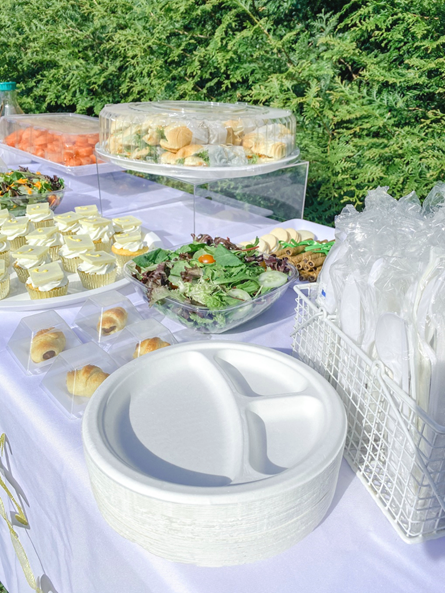
Environmental Impact Reduction: Reducing Plastic Waste
Compostable plates offer a remarkable solution to the mounting problem of plastic waste generated by weddings. Traditional disposable plates, often made from non-biodegradable materials like polystyrene or plastic, contribute to the buildup of landfills and pollution.
By choosing compostable catering trays for weddings, we can address the pressing issue of plastic waste and navigate towards more sustainable practices. These eco-friendly alternatives not only add elegance to the occasion but also minimize the environmental impact, ensuring that special celebrations leave a positive lasting impression on both guests and the planet.
In contrast, compostable plates are manufactured using organic materials such as palm leaves, sugarcane bagasse, or bamboo fibers that quickly break down into soil-nourishing compost. By incorporating compostable plates into wedding celebrations, couples can significantly reduce their plastic waste production and contribute to a healthier environment.
Decreased Carbon Footprint: Choosing Sustainability
Selecting compostable plates for weddings not only helps in diminishing plastic waste but also plays an essential role in reducing the carbon footprint associated with these events. The production process of traditional disposable plates involves high energy consumption and greenhouse gas emissions.
In contrast, compostable plate manufacturing involves minimal energy use and utilizes renewable resources that have a lower impact on the environment. By opting for compostable plates, couples demonstrate their commitment to sustainability and contribute towards mitigating climate change.
Aesthetically Pleasing Options Available: Reflecting Elegance
Gone are the days when eco-friendly options were perceived as lacking style or aesthetic appeal. Today's market offers an extensive range of compostable plate designs that cater to various wedding themes and decor styles.
From rustic-chic palm leaf patterns to sleek and modern bamboo designs, there is no shortage of visually appealing options available for couples seeking sustainable alternatives for their special day. Compostable plates can be found in a wide array of colors, shapes, and sizes - ensuring that they perfectly complement the overall ambiance of any wedding celebration.
Subtopics:
- Environmental Impact Reduction: Reducing Plastic Waste - Decreased Carbon Footprint: Choosing Sustainability - Aesthetically Pleasing Options Available: Reflecting Elegance
Types of Compostable Plates for Weddings:
Palm Leaf Plates: A Touch of Nature
When it comes to eco-friendly dinnerware for weddings, palm leaf plates stand out as a remarkable choice. Crafted from fallen palm leaves, these plates are produced without any harm to trees or the environment. The manufacturing process involves collecting naturally shed leaves and then cleaning and shaping them into elegant plates.
Palm leaf plates are not only visually appealing but also boast impressive biodegradability and composting capabilities. Thanks to their organic composition, they break down within a few months when disposed of properly in composting facilities or home compost piles.
Sugarcane Bagasse Plates: The Sustainable Sweetener
Derived from the fibrous residue left after extracting juice from sugarcane stalks, bagasse plates offer an excellent alternative for eco-conscious weddings. As a byproduct of sugar production, bagasse is abundantly available and would otherwise go to waste.
Incorporating bagasse disposable plates into eco-conscious weddings not only adds to the elegance of the event but also contributes to the reduction of waste. By utilizing bagasse, a readily available byproduct from sugar production, these plates provide a sustainable and earth-friendly choice that showcases a commitment to both elegance and environmental responsibility.
However, this versatile material is transformed into sturdy yet lightweight plates through a process that involves pressing and molding it into shape. Besides being environmentally friendly due to their fast rate of biodegradation, sugarcane bagasse plates exhibit impressive heat resistance, making them suitable for serving hot foods at weddings.
Bamboo Plates: A Graceful Harmony
With its rapid growth rate and sustainability, bamboo has gained popularity as an eco-friendly resource for various purposes – including dinnerware at weddings. Bamboo plates offer a harmonious balance between durability and lightness. Their sturdy construction ensures they can withstand the weight of various dishes while maintaining an effortlessly elegant appearance on wedding tables.
Being naturally renewable makes bamboo an ideal choice for those seeking sustainable alternatives without compromising on style or functionality. By considering these three options – palm leaf plates, sugarcane bagasse plates, and bamboo plates – couples can find the perfect compostable dinnerware that aligns with their preference for both environmental consciousness and aesthetic appeal.
Considerations when Choosing Compostable Plates for Weddings
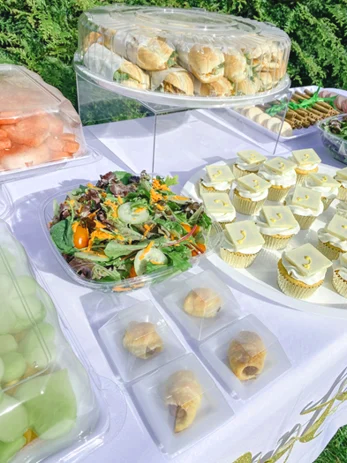
Quantity needed based on guest count
When selecting compostable plates for a wedding, it is crucial to estimate the quantity needed based on the expected number of guests. Careful planning will help ensure that there are enough plates to accommodate everyone without excessive waste or shortages.
It's advisable to have a precise headcount and then add a few extra plates as a buffer. Taking into account the duration of the event, including any cocktail hours or late-night snacks, will also play a role in determining the appropriate quantity.
Size options available (e.g., dinner, dessert)
Compostable plates for weddings come in various sizes to cater to different culinary needs. Dinner-sized plates are typically used for main courses and can comfortably hold generous portions without compromising stability.
For appetizers or desserts, smaller-sized compostable plates are more suitable as they allow guests to enjoy these delicacies without feeling overwhelmed by an oversized plate. It's essential to choose sizes that not only align with the menu but also provide visual appeal and practicality.
Compatibility with different types of food (e.g., sauces, liquids)
An important consideration when selecting compostable plates for weddings is their compatibility with various types of food, including those that involve sauces and liquids. Opting for sturdy and leak-resistant options ensures that plates won't become soggy and lose their structural integrity when exposed to moist foods. Look for compostable plates designed with built-in barriers or coatings that prevent leaks from seeping through during dining experiences, allowing guests to enjoy their meals without any inconvenience.
Certifications and standards (e.g., ASTM D6400, BPI certified)
To ensure the credibility and authenticity of compostable plates used at weddings, it is imperative to consider certifications and standards associated with their manufacturing processes. Look for plates that are ASTM D6400 certified, indicating they meet the criteria for compostability and biodegradability.
Additionally, seeking products certified by organizations like the Biodegradable Products Institute (BPI) provides assurance that the plates meet industry standards and best practices. These certifications act as a guarantee that the chosen compostable plates have undergone rigorous testing to ensure their eco-friendly attributes.
Proper Disposal and Composting Process
Educating guests on composting guidelines
When opting for compostable plates at weddings, it is essential to educate guests on the proper composting guidelines to ensure a smooth disposal process. One effective way to do this is by placing informative signs or pamphlets near the waste disposal area, providing clear instructions on how to separate and dispose of the compostable plates and other food waste.
These educational materials can include visual aids and step-by-step instructions, emphasizing the importance of correctly segregating organic waste from non-compostable items like plastic cutlery or napkins. By raising awareness about composting guidelines, guests will be encouraged to actively participate in the eco-friendly disposal process.
Working with local composting facilities or services
In order to ensure that the compostable plates used at weddings are disposed of properly, it is advisable to collaborate with local composting facilities or services. These organizations specialize in processing organic waste through controlled decomposition, resulting in nutrient-rich soil amendments that can be used for gardening or landscaping purposes.
By partnering with such facilities, wedding hosts can coordinate the collection and transport of leftover food waste and compostable plates after the event. This collaboration not only ensures a responsible disposal process but also supports sustainable practices within the local community.
Separating food waste from non-compostable items
To facilitate an efficient composting process, it is crucial to separate food waste from non-compostable items during clean-up. This can be done by providing designated bins for different types of waste: one for organic matter such as leftover food scraps and compostable plates, and another for non-compostable materials such as plastic utensils or packaging. It may be helpful to label these bins clearly so that guests can easily identify where each item should go.
Additionally, having dedicated staff or volunteers present during the event can help guide guests and ensure that the waste is correctly sorted. By separating food waste from non-compostable items, the composting process becomes more effective, maximizing the environmental benefits and minimizing contamination.
Overall, by educating guests on composting guidelines, collaborating with local composting facilities or services, and diligently separating food waste from non-compostable items, wedding hosts can ensure a proper disposal and composting process for their chosen compostable plates. This commitment to responsible waste management contributes to a greener wedding experience while promoting sustainability and environmental consciousness among attendees.
Cost Comparison: Compostable Plates vs. Traditional
Unveiling the Financial Verdict
When it comes to planning a wedding, financial considerations play a pivotal role. While compostable plates may initially appear to be more expensive than their traditional counterparts, a closer look reveals a more nuanced picture.
Though compostable plates generally have a higher upfront cost per unit, they often come with added value that can offset or even surpass the difference. For instance, many compostable plates are designed with durability in mind, reducing the risk of breakage during transport and serving.
This eliminates the need for extras and replacements, saving on overall costs. Additionally, some venues or waste management companies offer discounted rates or incentives for opting for eco-friendly alternatives.
Furthermore, when assessing the true cost of traditional plates, it is essential to consider post-event expenses like disposal fees and environmental impact mitigation. Traditional plates contribute to mounting plastic waste, which necessitates costly recycling processes or ends up in landfills—where they persist for centuries before decomposing.
Compostable plates offer an environmentally responsible solution by breaking down naturally into organic matter within months under optimal conditions. The avoidance of long-term environmental harm can result in significant savings when considering future cleanup efforts and potential regulatory fines related to waste management.




